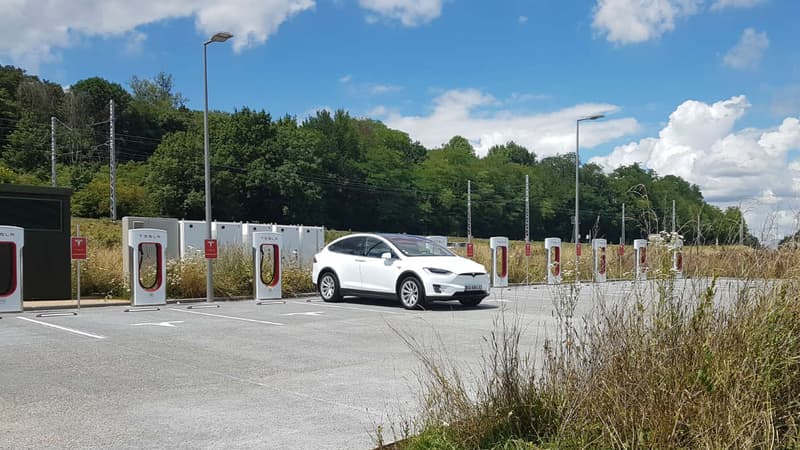Towards a race for superchargers? To celebrate 10 years since the installation of its first fast-charging stations, Tesla is offering all-day charging on August 29, from 9am to midnight, across Europe.
660 “open to all” stations in Europe
A nice publicity stunt for Elon Musk’s brand, which makes it clear that this offer is not reserved only for its customers. Since November 2021, Tesla has begun to open up its network to vehicles from other brands. A pilot experience launched in Europe in some stations and that would be conclusive since currently more than 70% of its network is open to all vehicles.
Tesla thus claims to offer “the largest ultra-fast charging network open to all in Europe, with to date more than 9,200 Superchargers distributed in 660 stations, accessible to all electric vehicles,” the brand says in a statement.
The idea would also be for Tesla to test the facility with expected high attendance. However, the announcement of this operation was made on the morning of August 29 and it will be interesting to see if it attracts many electric cars to take advantage of this gift in the 26 affected European countries.
strategic change
Tesla’s charging network has been part of its recipe for success since its inception. If charging an electric car can still be complicated today, the idea was “at the time” (the first station opened in 2012 in the United States) to offer a fast and reliable charging solution for long journeys, while the public network it was still very underdeveloped.
A selling point for its top-of-the-line Model S sedan as well. Until 2018, the vehicle was sold with “free supercharging for life,” even with a change of ownership.
Service then remained a major advantage, with a network that continued to grow in markets where Tesla is present. Before the opening to vehicles of other brands, the successive launches of the Model 3 (early 2019 in Europe), after the Model Y, with sales volumes that skyrocketed, also raised fears of greater network occupation and greater risk queues at their stations.
An essential asset in electrical warfare
But Tesla’s interest also remains in controlling an essential link in the electric vehicle ecosystem: enough to allow the particular brand to offer a route planner that has long been a benchmark in the market. Simply enter a destination in the browser and the vehicle will show you the different charging stages, with recommended stopping times and the remaining range upon arrival. With the possibility of redirecting to another station, depending on the occupation of the network, for example.
Another bonus left for Tesla customers: Simply plug in to start charging (with a bank card associated with the vehicle’s Tesla account). A concept called “Plug & Pay” that brands such as Mercedes now offer on the Ionity network and that simplifies operation, knowing that few terminals are equipped with a payment terminal and, therefore, require a specific card to start their recharge or payment through a QR code that links to a website to pay.
For non-brand customers, charging and payment management is done from the Tesla app, as the superchargers are not equipped with a display, just a simple cable to unhook from the mount.
A potential source of income and public support
With paid charging and opening up to all electric vehicles, Tesla can also count on its charging network to generate additional revenue from vehicle sales.
Especially with the opening of its network in the United States to other brands, announced for the beginning of 2024.
“The second quarter of 2023 was the quarter of supercharging. A significant number of companies, including Ford, GM, Mercedes, Nissan, Polestar, Rivian, Volvo and Electrify America, announced the adoption of NACS, a charging standard developed by Tesla for a decade — for its products sold in North America,” Tesla said in its latest financial results presentation.
The company added that this is how it will continue to develop its network, with a growing fleet of compatible vehicles.
If the “services and other income” of its results (2.150 million dollars in the second quarter) only represent less than 9% of its total turnover, they could represent a significant part of its activity in the coming years. Especially if this also gives you access to public aid for the installation of charging infrastructures:
“Tesla has a financial incentive to incorporate other electric vehicles [que ses propres modèles, NDLR]Because the United States government requires that chargers of electric vehicles collaborate with more than one manufacturer to have access to a financing of 7.5 billion dollars for the infrastructure of charging of electric vehicles”, explained the bank UBS recently in a note collected by BFM Bourse.
Analysts thus estimate the additional income potentially generated thanks to this opening to other brands at several billion dollars: 3 to 4 billion per year, just for the remaining access to Ford and GM vehicles in South America.
Source: BFM TV


